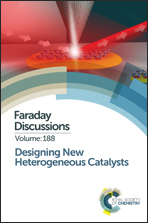Hydrothermal synthesis of bi-functional nanostructured manganese tungstate catalysts for selective oxidation†
Abstract
The mechanism of C–H activation in selective oxidation reactions of short-chain alkane molecules over transition metal oxides is critically affected by the balance of acid–base and redox sites at the surface of the catalyst. Using the example of manganese tungstate we discuss how the relative abundance of these sites can be controlled via synthetic techniques. Phase-pure catalysts composed of the thermodynamic stable monoclinic MnWO4 phase have been prepared using hydrothermal synthesis. Variation of the initial pH value resulted in rod-shaped nano-crystalline MnWO4 catalysts composed of particles with varying aspect ratio. The synthesis products have been analysed using transmission electron microscopy, X-ray diffraction, infrared, and photoelectron spectroscopy. In situ Raman spectroscopy was used to investigate the dissolution–re-crystallization processes occurring under hydrothermal conditions. Ethanol oxidation was applied to probe the surface functionalities in terms of acid–base and redox properties. Changes in the aspect ratio of the primary catalyst particles are reflected in the product distribution induced by altering the fraction of acid–base and redox sites exposed at the surface of the catalysts in agreement with the proposed mechanism of particle growth by re-crystallization during ageing under hydrothermal conditions.
- This article is part of the themed collection: Designing New Heterogeneous Catalysts

 Please wait while we load your content...
Please wait while we load your content...